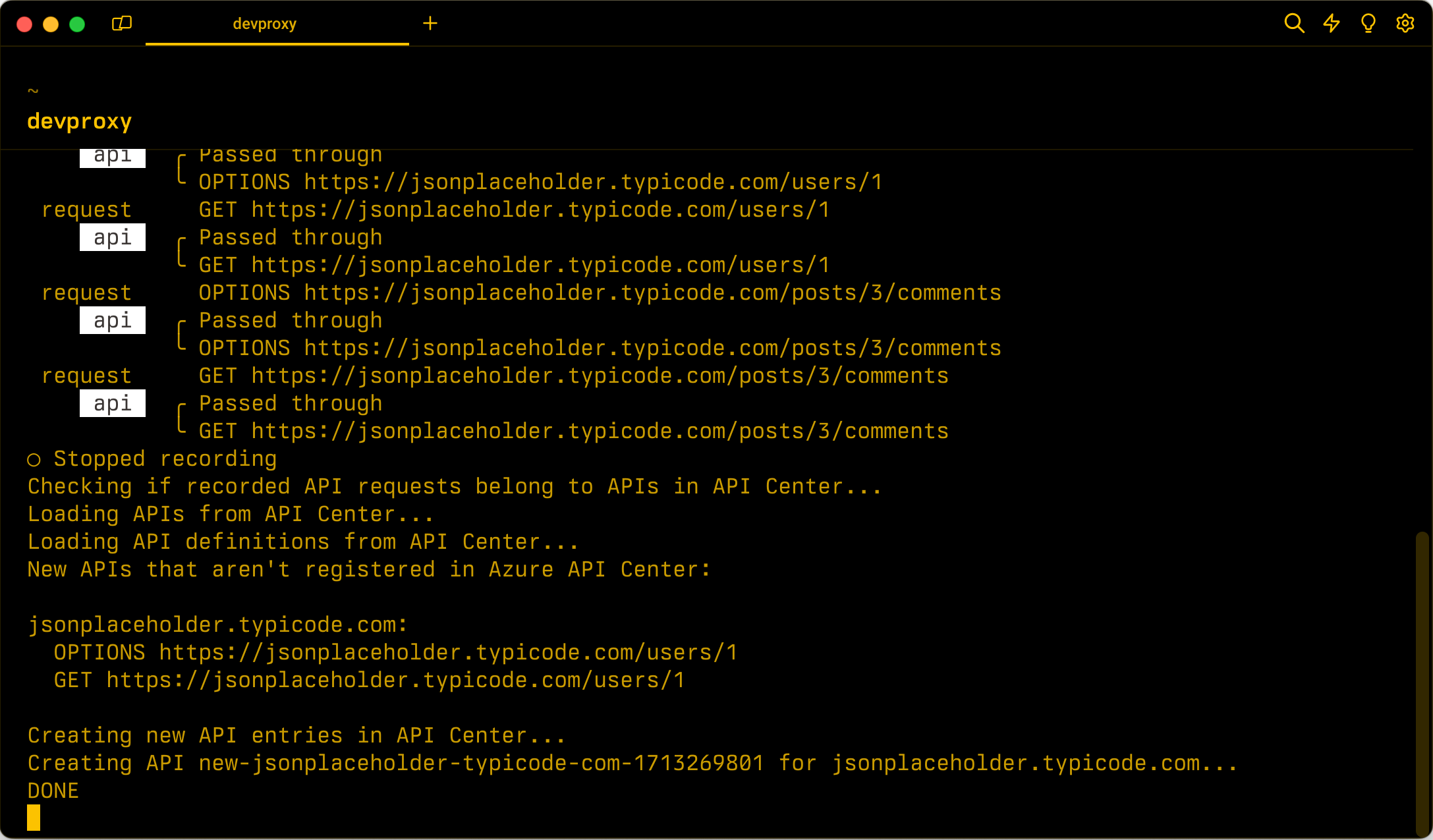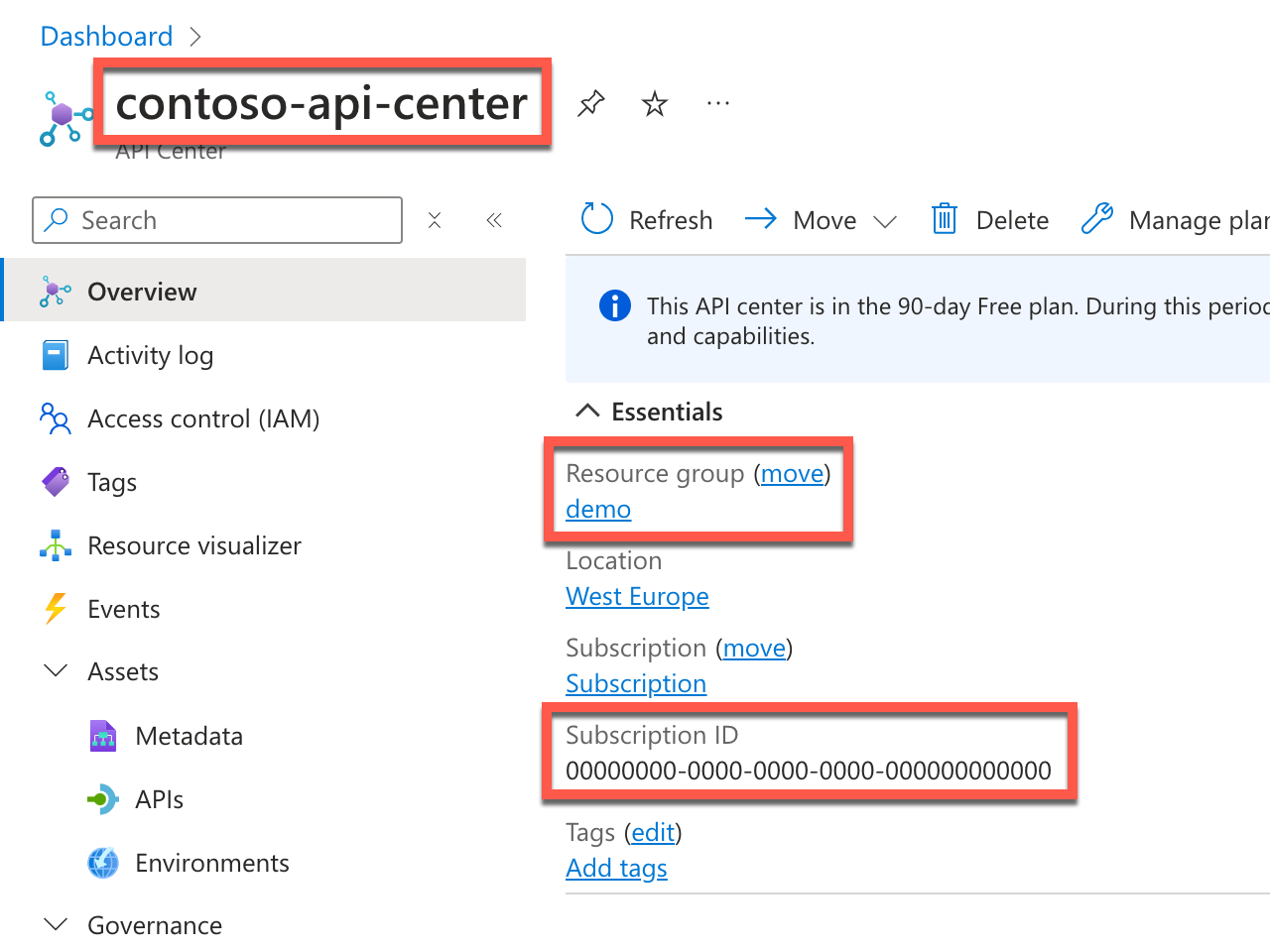Discover shadow APIs using Dev Proxy
Using Azure API Center you catalog APIs used in your organization. This allows you to tell which APIs you use, where the API is in its lifecycle, and who to contact if there are issues. In short, having an up-to-date catalog of APIs helps you improve the governance-, compliance-, and security posture.
When building your app, especially if you're integrating new scenarios, you might be using APIs that aren't registered in Azure API Center. These APIs are called shadow APIs. Shadow APIs are APIs that aren't registered in your organization. They might be APIs that aren't yet registered, or they might be APIs that aren't meant to be used in your organization.
One way to check for shadow APIs is by using Dev Proxy. Dev Proxy is an API simulator that intercepts and analyzes API requests from applications. One feature of Dev Proxy is checking if the intercepted API requests belong to APIs registered in API Center.
Before you start
To detect shadow APIs, you need to have an Azure API Center instance with information about the APIs that you use in your organization. If you haven't created one already, see Quickstart: Create your API center. Additionally, you need to install Dev Proxy.
Copy API Center information
From the Azure API Center instance Overview page, copy the name of the API Center instance, the name of the resource group and the subscription ID. You need this information to configure the Dev Proxy ApiCenterOnboardingPlugin so that it can connect to your Azure API Center instance.
Configure Dev Proxy
To check if your app is using shadow APIs, you need to enable the ApiCenterOnboardingPlugin in the Dev Proxy configuration file. To create a report of APIs that your app uses, add a reporter.
Enable the ApiCenterOnboardingPlugin
In the devproxyrc.json file, add the following configuration:
{
"$schema": "https://raw.githubusercontent.com/microsoft/dev-proxy/main/schemas/v0.19.0/rc.schema.json",
"plugins": [
{
"name": "ApiCenterOnboardingPlugin",
"enabled": true,
"pluginPath": "~appFolder/plugins/dev-proxy-plugins.dll",
"configSection": "apiCenterOnboardingPlugin"
}
],
"urlsToWatch": [
"https://jsonplaceholder.typicode.com/*"
],
"apiCenterOnboardingPlugin": {
"subscriptionId": "aaaa0a0a-bb1b-cc2c-dd3d-eeeeee4e4e4e",
"resourceGroupName": "demo",
"serviceName": "contoso-api-center",
"workspaceName": "default",
"createApicEntryForNewApis": false
}
}
In the subscriptionId, resourceGroupName, and serviceName properties, provide the information about your Azure API Center instance.
In the urlsToWatch property, specify the URLs that your app uses.
Tip
Use the Dev Proxy Toolkit Visual Studio Code extension to easily manage Dev Proxy configuration.
Add a reporter
The ApiCenterOnboardingPlugin produces a report of APIs that your app is using. To view this report, add a reporter to your Dev Proxy configuration file. Dev Proxy offers several reporters. In this example, you use the plain-text reporter.
Update your devproxyrc.json file with a reference to the plain-text reporter:
{
"$schema": "https://raw.githubusercontent.com/microsoft/dev-proxy/main/schemas/v0.19.0/rc.schema.json",
"plugins": [
{
"name": "ApiCenterOnboardingPlugin",
"enabled": true,
"pluginPath": "~appFolder/plugins/dev-proxy-plugins.dll",
"configSection": "apiCenterOnboardingPlugin"
},
{
"name": "PlainTextReporter",
"enabled": true,
"pluginPath": "~appFolder/plugins/dev-proxy-plugins.dll"
}
],
"urlsToWatch": [
"https://jsonplaceholder.typicode.com/*"
],
"apiCenterOnboardingPlugin": {
"subscriptionId": "aaaa0a0a-bb1b-cc2c-dd3d-eeeeee4e4e4e",
"resourceGroupName": "demo",
"serviceName": "contoso-api-center",
"workspaceName": "default",
"createApicEntryForNewApis": false
}
}
Check if your app is using shadow APIs
To check if your app is using shadow APIs, connect to your Azure subscription, run Dev Proxy, and let it intercept API requests from your app. Dev Proxy then compares the information about the API requests with the information from Azure API Center and reports on any APIs that aren't registered in API Center.
Connect to your Azure subscription
Dev Proxy uses information from Azure API Center to determine if your app is using shadow APIs. To get this information, it needs a connection to your Azure subscription. You can connect to your Azure subscription in several ways.
Run Dev Proxy
After connecting to your Azure subscription, start Dev Proxy. If you start Dev Proxy from the same folder where your devproxyrc.json file is located, it automatically loads the configuration. Otherwise, specify the path to the configuration file using the --config-file option.
When Dev Proxy starts, it checks that it can connect to your Azure subscription. When the connection is successful, you see a message similar to:
info Plugin ApiCenterOnboardingPlugin connecting to Azure...
info Listening on 127.0.0.1:8000...
Hotkeys: issue (w)eb request, (r)ecord, (s)top recording, (c)lear screen
Press CTRL+C to stop Dev Proxy
Press r to start recording API requests from your app.
Use your app
Use your app as you would normally do. Dev Proxy intercepts the API requests and stores information about them in memory. In the command line where Dev Proxy runs, you should see information about API requests that your app makes.
info Plugin ApiCenterOnboardingPlugin connecting to Azure...
info Listening on 127.0.0.1:8000...
Hotkeys: issue (w)eb request, (r)ecord, (s)top recording, (c)lear screen
Press CTRL+C to stop Dev Proxy
◉ Recording...
req ╭ GET https://jsonplaceholder.typicode.com/posts
api ╰ Passed through
req ╭ DELETE https://jsonplaceholder.typicode.com/posts/1
api ╰ Passed through
Check shadow APIs
Stop the recording by pressing s. Dev Proxy connects to the API Center instance and compares the information about requests with the information from API Center.
info Plugin ApiCenterOnboardingPlugin connecting to Azure...
info Listening on 127.0.0.1:8000...
Hotkeys: issue (w)eb request, (r)ecord, (s)top recording, (c)lear screen
Press CTRL+C to stop Dev Proxy
◉ Recording...
req ╭ GET https://jsonplaceholder.typicode.com/posts
api ╰ Passed through
req ╭ DELETE https://jsonplaceholder.typicode.com/posts/1
api ╰ Passed through
○ Stopped recording
info Checking if recorded API requests belong to APIs in API Center...
info Loading APIs from API Center...
info Loading API definitions from API Center...
When Dev Proxy finishes its analysis, it creates a report in a file named ApiCenterOnboardingPlugin_PlainTextReporter.txt with the following contents:
New APIs that aren't registered in Azure API Center:
https://jsonplaceholder.typicode.com:
DELETE https://jsonplaceholder.typicode.com/posts/1
APIs that are already registered in Azure API Center:
GET https://jsonplaceholder.typicode.com/posts
Automatically onboard shadow APIs
The ApiCenterOnboardingPlugin can not only detect shadow APIs, but also automatically onboard them to API Center. To automatically onboard shadow APIs, in the Dev Proxy configuration file, update the createApicEntryForNewApis to true.
{
"$schema": "https://raw.githubusercontent.com/microsoft/dev-proxy/main/schemas/v0.19.0/rc.schema.json",
"plugins": [
{
"name": "ApiCenterOnboardingPlugin",
"enabled": true,
"pluginPath": "~appFolder/plugins/dev-proxy-plugins.dll",
"configSection": "apiCenterOnboardingPlugin"
},
{
"name": "PlainTextReporter",
"enabled": true,
"pluginPath": "~appFolder/plugins/dev-proxy-plugins.dll"
}
],
"urlsToWatch": [
"https://jsonplaceholder.typicode.com/*"
],
"apiCenterOnboardingPlugin": {
"subscriptionId": "aaaa0a0a-bb1b-cc2c-dd3d-eeeeee4e4e4e",
"resourceGroupName": "demo",
"serviceName": "contoso-api-center",
"workspaceName": "default",
"createApicEntryForNewApis": true
}
}
When you run Dev Proxy with createApicEntryForNewApis set to true, it automatically creates new API entries in Azure API Center for the shadow APIs that it detects.
Automatically onboard shadow APIs with OpenAPI spec
When you choose to automatically onboard, shadow APIs to API Center, you can have Dev Proxy generate the OpenAPI spec for the API. Onboarding APIs with OpenAPI specs speeds up onboarding of missing endpoints and provide you with the necessary information about the API. When the ApiCenterOnboardingPlugin detects, that Dev Proxy created a new OpenAPI spec, it associates it with the corresponding onboarded API in API Center.
To automatically generate OpenAPI specs for onboarded APIs, update Dev Proxy configuration to include the OpenApiSpecGeneratorPlugin.
{
"$schema": "https://raw.githubusercontent.com/microsoft/dev-proxy/main/schemas/v0.19.0/rc.schema.json",
"plugins": [
{
"name": "OpenApiSpecGeneratorPlugin",
"enabled": true,
"pluginPath": "~appFolder/plugins/dev-proxy-plugins.dll"
},
{
"name": "ApiCenterOnboardingPlugin",
"enabled": true,
"pluginPath": "~appFolder/plugins/dev-proxy-plugins.dll",
"configSection": "apiCenterOnboardingPlugin"
},
{
"name": "PlainTextReporter",
"enabled": true,
"pluginPath": "~appFolder/plugins/dev-proxy-plugins.dll"
}
],
"urlsToWatch": [
"https://jsonplaceholder.typicode.com/*"
],
"apiCenterOnboardingPlugin": {
"subscriptionId": "aaaa0a0a-bb1b-cc2c-dd3d-eeeeee4e4e4e",
"resourceGroupName": "demo",
"serviceName": "contoso-api-center",
"workspaceName": "default",
"createApicEntryForNewApis": true
}
}
Important
Dev Proxy executes plugins in the order they're registered in the configuration. You need to register the OpenApiSpecGeneratorPlugin first so that it can create OpenAPI specs before the ApiCenterOnboardingPlugin onboards new APIs.
When you run Dev Proxy with this configuration, it automatically creates new API entries in Azure API Center for the shadow APIs that it detects. For each new API, Dev Proxy generates an OpenAPI spec and associates it with the corresponding onboarded API in API Center.
info Plugin ApiCenterOnboardingPlugin connecting to Azure...
info Listening on 127.0.0.1:8000...
Hotkeys: issue (w)eb request, (r)ecord, (s)top recording, (c)lear screen
Press CTRL+C to stop Dev Proxy
◉ Recording...
req ╭ GET https://jsonplaceholder.typicode.com/posts
api ╰ Passed through
req ╭ DELETE https://jsonplaceholder.typicode.com/posts/1
api ╰ Passed through
○ Stopped recording
info Creating OpenAPI spec from recorded requests...
info Created OpenAPI spec file jsonplaceholder.typicode.com-20240614104931.json
info Checking if recorded API requests belong to APIs in API Center...
info Loading APIs from API Center...
info Loading API definitions from API Center...
info New APIs that aren't registered in Azure API Center:
https://jsonplaceholder.typicode.com:
DELETE https://jsonplaceholder.typicode.com/posts/1
info Creating new API entries in API Center...
info Creating API new-jsonplaceholder-typicode-com-1718354977 for https://jsonplaceholder.typicode.com...
info DONE
Summary
Using Dev Proxy and its ApiCenterOnboardingPlugin, you can check if your app is using shadow APIs. The plugin analyzes API requests from your app and reports on any API requests that aren't registered in Azure API Center. The plugin allows you to easily onboard missing APIs to API Center. By combining the ApiCenterOnboardingPlugin plugin with the OpenApiSpecGeneratorPlugin, you can automatically generate OpenAPI specs for the newly onboarded APIs. You can run this check manually or integrate with your CI/CD pipeline to ensure that your app is using registered APIs before releasing it to production.



